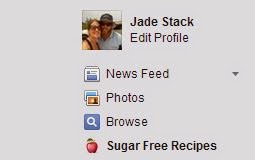The topic of eating fat is very controversial. People’s perception of ‘fat’ isn't quite up to
science. Science is way ahead. Kind of reminds me of smoking. My mother smoked in the maternity ward when I was born, it’s taken a long time for the science of smoking to convince people to quit. Some still aren't convinced. I think eating fat will be the same. Some will never be convinced. Others started eating good fats decades ago and didn't need the science.
Before I write about my own personal beliefs about fat, it is important for me to point out that not everyone will agree with this. Just like sugar. Some people think it's crazy cutting out refined sugar and some people will think that eating fat is never going to be good. Like the old saying goes, "you can lead a horse to water, but you can't make it drink". I'll write my thoughts on fat and hopefully you can use this knowledge to make more informed decisions about what healthy eating means for you.
 For me, fat is a huge part of my diet. It has been ever since I started this 'sugar-free' journey, especially after reading "Eat Fat, Lose Fat" by Dr Mary Enig and Sally Fallon (authors of the nourishing traditions - another GREAT book). David Gillespie and Sarah Wilson are obviously two well known advocates for eating good fats and their websites, blogs and books are a wealth of knowledge.
For me, fat is a huge part of my diet. It has been ever since I started this 'sugar-free' journey, especially after reading "Eat Fat, Lose Fat" by Dr Mary Enig and Sally Fallon (authors of the nourishing traditions - another GREAT book). David Gillespie and Sarah Wilson are obviously two well known advocates for eating good fats and their websites, blogs and books are a wealth of knowledge.
Here are a few facts about fat.
There are 3 basic types of fats found in food; saturated, monounsaturated and polyunsaturated. There is one artificial fat also found in our food and is the one to be completely avoided; Trans Fat.
To sum it up quickly, saturated fats are found mostly in animal fats and tropical fats such as coconut oil. LOADS of websites will tell you that this fat will lead to high cholesterol and blood pressure but I beg to differ. Monounsaturated fats are the main component of olive oil and sesame oil along with being found in almonds, pecans, cashews, peanuts and avocados. Polyunsaturated fats are so-called vegetable oils that go rancid easily when heated. Most of these oils go through a hydrogenation process, which is what makes them unusable to the body. Trans Fats are artificially made and found in manufactured foods, such as baked goods, some frozen foods, margarine, chips, fast-food fries and countless other products. Trans Fats are dangerous because they can be made cheaply and because their inclusion helps packaged foods to last nearly forever. Sarah Wilson says that she'd prefer to eat sugar over trans fats - that says a lot.
Now to coconut oil.
Coconut Oil is the queen of saturated fats. Coconut oil is a medium chain fatty acid (MCFA)
that does not need bile salts (secreted by the gallbladder) to digest it. That is why, if you are reintroducing fats into your diet, it’s best to begin with coconut oil.
The main MCFA in coconut oil is lauric acid, a proven antiviral, antibacterial and anti fungal agent which is also found in mothers milk. Lauric acid is then converted to a substance called monolaurin, which has antimicrobial properties and will help your body fight disease organisms including viruses, bacteria and parasites.
Coconut oil has also been linked to weight loss by boosting your immune system, reducing your appetite and helping you lose fat (especially that dangerous abdominal fat).
This website is full of anecdotes of people using coconut oil as weight loss. Click here to view the forums.
 |
| This is exactly what I have |
Apart from coconut oil being good for you internally, anyone who knows me well, will know that that I have a love affair with coconut oil. I use it to make my toothpaste and as an all over moisturizer. I have some in my bedroom, bathroom, kitchen, my handbag and in my car. I mix it with sunscreen to use on my face and also use it to kill head lice (in conjunction with vinegar) in my daughters hair. Infact, I use it in my daughters hair just to brush it. I use it on stings, bites and scratches and it makes a great massage oil on its own or with a drop of essential oil added. I love this stuff. It goes in shakes, I shallow fry in it, add it to stews, use it on BBQ's and nearly everything (although I don't like it in my tea). I buy it online here in 2 x 5L containers. I simply put it in the shower or the bath with my kids during colder months to liquefy it so I can refill my other containers. In February I paid $154 for 10L and this INCLUDED delivery to a remote community.
All of this stuff can be hard to remember. I've read it a million times but still need to clarify what a long chain fatty acid is, where the atoms are, does it bend, is it stable, does it go rancid etc etc
To make life easier in my house, I have this printed and in my pantry.
Personally, I avoid palm oil for ethical reasons. This facebook page;
'PALM OIL - Products on Australian shelves that contain Palm Oil' gives me constant reminders of the products I need to avoid in Australia if I want to avoid palm oil.
Another great poster, which makes a lot of sense is this one.


















